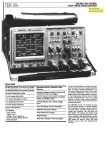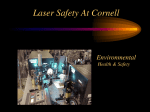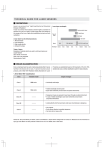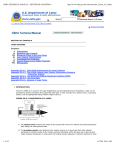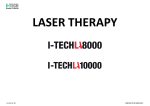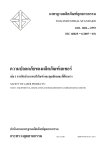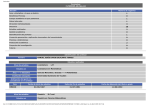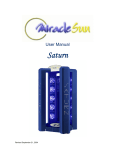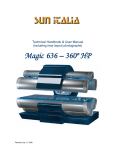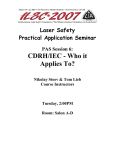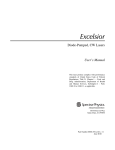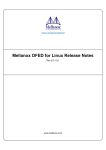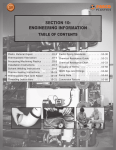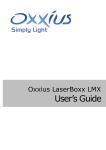Download LASER SAFETY MANUAL - Case Western Reserve University
Transcript
LASER SAFETY MANUAL Environmental Health and Safety Revised December 17, 2014 CWRU EHS Laser Safety Manual Table of Contents I. INTRODUCTION 3 II. RESPONSIBILITIES 4 III. SAFETY FUNDAMENTALS A. Laser Classification B. Laser Registration C. Laser Hazards D. Engineering Controls E. Administrative Controls F. Personal Protective Equipment G. Medical Surveillance 5 6 6 10 11 12 13 TABLE 1 Minimum Optical Density for Eyewear 12 TABLE 4 Selecting Eye Protection for Intra-beam Viewing 13 APPENDIX A Glossary of Terms 14 APPENDIX B Administrative and Engineering Control Measures 16 APPENDIX C Laser Registration Training and Relocation Form 18 APPENDIX D Laser Exposure Incident Report 19 APPENDIX E Laser Signs 20 APPENDIX F Optical Portions of Electromagnetic Spectrum 21 APPENDIX G Good Laser Safety Work Practices 22 APPENDIX H Common Causes of Laser Accidents 23 APPENDIX I 24 Laser Eye Damage Wavelengths APPENDIX J Indicators and Symptoms of Laser Eye Injury 25 APPENDIX K Laser Related Calculation Information 26 APPENDIX L Medical Surveillance Requirements 28 APPENDIX M Laser Compliance Checklist 29 APPENDIX N Laser Hazard Assessment Checklist 32 APPENDIX O Lab Specific Laser Training Log and Acknowledgement 35 APPENDIX P Lab Specific Laser Retraining Log and Acknowledgement 36 CWRU EHS Laser Safety Manual I. INTRODUCTION Class 3B or 4 lasers can present a major hazard through exposure to the direct (intra-beam) or reflected (specular or diffuse) laser beams when the laser is inadvertently “on” and there is a direct line-of-sight path to the laser beam or its reflection. Additional hazards associated with the use of lasers include electric shock from high voltage power supplies, burns from fires, injuries from the use or storage of compressed gases, breathing of Laser Generated Air Contaminants (LGACs), noise and explosions from targets or lamps to name a few. This document presents guidelines to minimize risks and protect Case Western Reserve University (CASE) employees from the hazards associated with indoor lasers and laser system operations. The intent of this manual is to ensure the safe use of lasers through engineering and administrative controls. This objective shall be accomplished by identifying potential hazards (hazard assessment), providing recommendations for hazard control, and training laser operators and incidental personnel. The requirements and recommendations detailed in this program are applicable to all lasers used in research and instructional laboratories which are operated by CASE. This document provides guidance for compliance with applicable State and Federal regulations along with the American National Standard for the Safe Use of Lasers, ANSI Z136.1-2014, Center for Devices and Radiological Health (CDRH), Food and Drug Administration, Occupational Safety and Health Administration (OSHA) and is recognized as a minimum standard for laser safety. This document is intended to be used in conjunction with the information found in the CASE Laser Slide presentation. The ANSI Laser Hazards and related standards include the following references: ANSI Z87.1-1989: Practice for Occupational and Educational Eye and face Protection ANSI Z136.1-2014 American National Standard for the Safe Use of Lasers ANSI Z136.2-1988 American National Standard for the Safe Use of Optical Fiber Communications Systems Utilizing Laser Diodes and LEDs ANSI Z136.3-1996 American National Standard for the Safe Use of Lasers in the Health Care Environment ANSI Z136.5-2000 Safe Use of Lasers in Educational Institution ANSI Z136.6-2000 Safe Use of Lasers Outdoors FAA 7400.2D Guidelines for Use of Lasers Outdoors (this is not a title) FDA, 21 CFR Subchapter J: Federal Laser Product Performance Standard OSHA Technical Manual (TED 1-0.15A), Section 111- Chapter 6, (January 1999) CDRH: Federal Laser Product Performance Standard 1976 CWRU EHS Laser Safety Manual II. RESPONSIBILITIES A. Environmental Health and Safety (EHS) 1. Conduct periodic laser laboratory/facility inspections to ensure that laser safety requirements are being met. 2. Provide assistance in evaluating laser hazards: minimizing beam and non-beam hazards. 3. Recommend laser safety controls including administrative, engineering, and personal protective equipment (PPE). 4. Maintain records of laser locations, class, owners and users as provided by the PIs. 5. Conduct and or coordinate laser safety training for laser operators and incidental personnel. 6. Investigate accidents involving lasers and follow up as necessary to preclude recurrence. 7. Update the CASE Laser Safety Program as needed. B. Principal Investigator 1. Register all lasers with the LSO by completing a Laser Registration Form (Appendix C) for each new laser received within the laboratory. New lasers require LSO inspection. 2. Notify the LSO of each modified laser and of each laser transferred or disposed. 3. Provide and document a hazard assessment for each laser in use. LSO may assist. 4. Ensure all laser work practices are adequately or safely planned and controlled. 5. Maintain an up-to-date MAP, laser inventory and list of all laser workers in the laboratory. 6. Provide, implement, and enforce all safety recommendations and requirements for the safe use of lasers by all laser users in the lab and especially those noted in ANSI Standard Z136.1-2014, section 4.3.10.1/.2, p19. 7. Provide on-going annual laser user training in the administrative, alignment, and SOPs for all your lab laser users for both old and new laser or laser related equipment. 8. Attend initial and refresher laser safety training provided or coordinated by the LSO. 9. Notify LSO at once in the event of any injury due to the use of a Class 3B or 4 laser. C. Laser Operator Responsibilities 1. Follow laboratory engineering, administrative, alignment, and SOPs. 2. Keep the Principal Investigator fully informed of any departure from established safety including all over exposure incidents. 3. Attend initial laser training and any additional training coordinated by the LSO. D. Laser Safety Officer (LSO) 1. Inspect, monitor, enforce and evaluate the Laser Safety Program for each laser as required to minimize laser hazards and the risk of injury at CASE. E. Employee Responsibilities 1. Recognize and adhere to the laboratory signage and applicable written safety protocols. 2. Attend laser safety awareness training for incidental personnel. 3. Do not enter areas that contain unfamiliar equipment. CWRU EHS Laser Safety Manual III. SAFETY FUNDAMENTALS A. Classification Lasers are divided into a number of classes depending upon the power or energy of the beam and the wavelength of the emitted radiation. Laser classification is based on the laser’s potential for causing immediate injury to the eye or skin and/or potential for causing fires from direct exposure or diffuse reflective surfaces. Commercially produced lasers have been classified and identified by labels affixed to the laser since August 1, 1976. In cases where the laser has been fabricated on campus or is otherwise not labeled, the LSO will assist with properly classifying and labeling the laser. Lasers are classified using physical parameters of the laser including power, wavelength, and exposure duration (NOTE: All pulsed lasers operating in the visible ocular focus region 400-1400 nm should be considered Class 4). Class 1 » Not capable of producing damaging radiation levels during operation or maintenance. » Class 1 lasers are sealed in an enclosure that prohibits or limits access to the laser radiation (i.e., a laser printer). Beam power is less than 0.4 uW for visible CW lasers. » Exempt from control measures Class 2 » All Class 2 lasers operate within the visible region of the spectrum (400-700 nm) » Output is not intended to be viewed (for example, a grocery scanner) » Eye protection is normally afforded by the aversion response to bright light (blink). » Class 2 lasers shall have a “Caution” sign posted on the outside of the door. Class 3R » Power output is up to 5 times greater than Class II - 5m W. » Laser or laser systems that would not normally produce a hazard if viewed for only a moment with the unaided eye (for example a laser pointing device). Class 3B » Maximum power output is less than 500 mW. » CW lasers operate between the upper Class 3R limits (5mW) and the maximum power for Class 3B lasers (500 mW). » Diffuse reflections are usually not hazardous. However, lasers or laser systems may produce a hazard if viewed directly through intrabeam viewing or specular reflections. » Class 3B lasers shall have a “Danger” sign posted on the outside of the door. Class 4 » Power exceeds Class 3B limits of 500mW. » High-powered lasers and laser systems capable of causing severe eye damage with short duration exposures (0.25 seconds) to the direct, specularly, or diffusely reflected beam. » Can ignite flammable and combustible materials. » May produce laser generated air contaminants or hazardous plasma radiation. » Class IV lasers shall have a “Danger” sign posted on the outside of the door. CWRU EHS Laser Safety Manual B. Laser Registration The Principle Investigator is responsible for all laser safety precautions by class for the lasers used. Fill out a Laser Registration Form (Appendix C) and return it to the LSO for each new or modified Class 2, Class 3R, Class 3B, and Class 4 laser systems in use. Changes in the use of the laser, its location or transfer requires notification to the LSO. Fill out the Laser Relocation Form (Appendix D) and fax to the LSO (368-2236) prior to moving a laser system. If you have any questions about these forms contact the LSO at (368-8591) or [email protected]. C. Laser Hazards 1. Beam Hazards The Eye The eye is easily injured by laser beams. The type of injury depends upon the intensity of light, its wavelength, and the tissue being exposed. Damage is by high temperature or photochemical effects. Acute exposures may result in corneal or retinal burns. Cataract formation and retinal damage may result from chronic exposures to laser light. Retinal damage from exposure to wavelengths in the visible and near infrared region is of concern. Incoherent light can be viewed safely because the light reaching the eye is but a fraction of the output energy and is spread over the entire retina. Laser radiation is coherent light. Wavelengths of 315-400 nm are absorbed largely in the lens. The beam passes through the pupil and focuses on a very small spot on the retina, depositing all its energy in this area. Only visible and near infrared radiation is focused on the retina. Damage to the retina may result in limited or total blindness if the optic nerve or macula region is injured. Injury may be irreversible and there may be no pain or discomfort. See Appendix L for Laser Eye Damage Wavelengths chart. The Skin Skin can be damaged by laser beams. Acute exposure may cause injuries ranging from mild reddening to blistering and charring. Skin cancers may result from chronic exposure to ultraviolet light. The extent and type of damage depends on the amount of energy deposited and the wavelength of the light. Unlike injury to the eye, acute damage to the skin is usually repairable. CWRU EHS Laser Safety Manual The chart below outlines the biological effects to the eyes and skin at a variety of wavelengths. Only visible and near infrared wavelengths are focused on the retina. Eye Skin Actinic UV: Ultraviolet C (100-280 nm) Cornea: photokeratitis Erythema (sunburn) Skin cancer Aging of skin Actinic UV: Ultraviolet B (280-315 nm) Cornea: photokeratitis Increased pigmentation Lens: photochemical cataracts Retina: blue light injury Pigment darkening Skin burns Visible (400 nm –700 nm) Retinal burns: thermal injury Infrared A (760–1400 nm ) Cataracts and retinal burns Pigment darkening Photosensitive reactions Skin burns Skin burns Infrared B (1400-3000 nm) Cornea: burns Aqueous flare (fluorescence) Lens: cataracts Cornea: burns Spectral Wavelength Near UV: Ultraviolet A (315–400 nm) Infrared C (3000 nm–1 mm) Skin burns Skin burns Some high powered mode-locked short pulsed lasers can mechanically disrupt the retina causing hemorrhage (Nd-YAG Lasers). XeCl lasers (308 nm) emit UV in the ultraviolet acute cataract action spectrum and require special precautions. Please give these lasers additional focus for laser safety. There are a variety of types of beam exposures that are not limited to intrabeam viewing. For high powered lasers, the specular or diffuse reflection may be equally as damaging. Quartz discharge tubes may emit collateral UV radiation. Broadband irradiance (400-550nm) from welding arcs may create potential point source overexposures in 10-20 min. (blue-light region). CWRU EHS Laser Safety Manual Intrabeam Exposures The skin or eye is exposed directly to all or part of the laser beam resulting in a full exposure to the irradiance of the beam. Specular Reflections The reflection from a smooth or mirrored surface when the roughness is l.t. the wavelength of incident light. Items such as jewelry or wrist watch cover glass produce specular reflections. These items should be removed prior to operating a laser. Exposure to specular reflections can be as equally dangerous as intrabeam viewing and reflections from Class 4 lasers may cause a fire (at 0.5 w/cm2 CW). Beam Alignment and Elevation It is highly recommended that laser users and PIs document, prior to use, that laser alignment is correct and the search for unwarranted dangerous reflections or errant beams was negative. As a precaution, beams are not to be elevated anywhere on the optical bench. Diffuse Reflections A non-uniform reflection from a rough surface whose roughness is g.t. the wavelength of incident light. Diffuse reflections scatter the beam and do not carry the full power of an intrabeam. Diffuse beams have a maximum upward vertical irradiant component perpendicular to the source impact. Note: In tuning a laser from one wavelength to another, one may be moving from diffuse to specular reflections or vice versa. Know your surfaces and how they reflect! 2. Non-Beam Hazards In addition to the beam hazards of a laser, other hazards may be associated with laser operations. These nonbeam hazards include electrical shocks, explosions, flammable liquids, compressed gases, noise, UV radiation, dyes and solutions, and laser generated air contaminants. Safety considerations that may go into the assessment and evaluation of laser hazards include electrical skin exposure, chemical and associated gas hazards. Some other special considerations include whether the laser is enclosed in an engineered system of protection, the beam is invisible, maintenance, repair, and if modifications will be necessary on a routine basis or whether there is a potential for explosion, fire, or hazardous fumes. Electrical Electrical dangers pose the most significant risk among the non-beam hazards. Several accidents within the U.S. have resulted in electrocution. To reduce electrical hazards, high voltage sources and terminals must be enclosed unless the work area is restricted to qualified persons only. Whenever feasible, power must be turned off and all high-voltage points grounded before working on power supplies. Capacitors must be equipped with bleeder resistors, discharge devices, or automatic shorting devices. Other general guidelines to follow include: » Never wear jewelry when operating a laser. Metal jewelry can be conductive. Jewelry in general can create a specular reflection hazard. This includes wrist watches. » Use the one hand rule when working on circuits. » Avoid standing in water and assume that all floors are conductive when working with high voltage. » Use rubber gloves and insulating floor mats when available. Do not work alone. » Maintain access to main power shutoff. Another good practice to have at least one person in the work area that is trained and certified in cardiopulmonary resuscitation (CPR) in the event that this form of first aid is required. CWRU EHS Laser Safety Manual Explosions Lasers and ancillary equipment may present explosion hazards. High pressure arc or filament lamps used to excite the lasing medium must be enclosed in housings that can withstand an explosion if the lamp disintegrates. In addition, the laser target and elements of the optical train may shatter during laser operation and should be enclosed in a suitable protective housing. Capacitors may explode if subjected to voltages higher than their rating and must be adequately shielded. It is recommended that capacitors be equipped with current-limiting devices. High energy capacitors should be enclosed in one eighth inch thick steel cabinets. Flammables Flammable solvents, gases, and combustible materials may be ignited by a Class 4 laser beam. Laser beams should be terminated by a non-combustible material such as a brick. Combustible solvents or materials should be stored in proper containers and shielded from the laser beam or electrical sparks. Lasers and laser facilities should be constructed and operated to eliminate or reduce any fire hazard. Unnecessary combustible materials should be removed in order to minimize fire hazards. Laser laboratories should contain an appropriate fire extinguisher. Compressed Gases Many hazardous gases are used in lasers including chlorine, fluorine, hydrogen chloride, and hydrogen fluoride. SOPs must be developed for the safe handling of compressed gases that include: » Cylinders must be attached to a cart or secured by a chain or strap, not free standing. » Different gases (oxidizers, corrosives, flammables, toxics) must be stored separately. » Please follow all posted safety procedures for changing out the gas cylinders. Noise Noise levels in laser laboratories can exceed safe limits because of high voltage capacitor discharges. Hearing protection may be required. The LSO will provide a noise survey to determine whether noise levels exceed safe limits. UV Radiation Laser discharge tubes and pumping tubes may emit hazardous levels of ultraviolet radiation called “collateral UV” and should be suitably shielded. UV radiation can cause photodermatitis along with exposure to industrial chemicals or with certain medications. Laser Dyes and Solutions Laser dyes are complex fluorescent organic compounds which, when in solution with certain solvents, form a lasing medium for dye lasers. Certain dyes are highly toxic or carcinogenic. These dyes are frequently changed and special care must be taken when handling, preparing solutions, and operating dye lasers. A Material Safety Data Sheet (MSDS) for dye compounds shall be made available to all appropriate workers. Laser Generated Air Contaminants (LGAC) Air contaminants may be generated when certain Class 3 and Class 4 laser beams interact with matter. The quantity, composition, and chemical complexity of the LGAC depend greatly upon the target material, cover gas, and beam irradiance. The LSO will ensure that the industrial hygiene aspects of exposure to LGAC are addressed and that the appropriate control measures are used. CWRU EHS Laser Safety Manual D. Engineering Controls Engineering controls are the priority means of minimizing the possibility of accidental exposures to laser hazards. If engineering controls are impractical or inadequate, then safety should be supported through the use of administrative procedures and personnel protective equipment. Engineering controls that may prove useful and effective in improving the safety of a laser or laser system are provided in the following list: 1. Protective Housing and Interlocks A protective housing is a physical barrier sufficient to contain the beam and laser radiation from exiting the laser system so that the maximum permissible exposure (MPE) is not exceeded on the outside surface. Protective housing must be interlocked so that the laser cannot operate when the housing is opened or removed when the requirements of a protective housing are fulfilled, the laser system is considered a Class 1 laser and no further control measures are required. 2. Laser Use Without Protective Housing In the research environment, lasers are often used without a protective housing in place. The use of optical tables and optical devices are typically employed in order to manipulate the laser beam. In this environment, the LSO will evaluate the hazards and recommend control measures to ensure safe operation. These control measures may include but are not limited to the following: » Access restriction » Procedural controls » Area controls » Barriers, curtains, and beam stops » Eye protection » Training 3. Access Restriction For Class 3B and Class 4 laser laboratories, access controls are required to prevent unauthorized personnel from entering the area when the laser is in use. Doors must be kept closed when the laser is in operation. Secondary doors that can allow access to a laser in operation must be either locked or posted similarly to the primary entrance. 4. Laser Use Area Control Class 3B and Class 4 laser area control measures are used to minimize laser radiation hazards. The area must be posted with the appropriate signage and include a lighted sign at the doorway indicating the “on” status of a laser system. Only authorized personnel who have been appropriately trained will be allowed to operate the laser. Control of the laser beam path shall be accomplished in the following manner: » Totally Unenclosed Beam Path Where the entire beam path is unenclosed, a laser hazard analysis shall be performed by the LSO to establish the nominal hazard zone (NHZ) if not furnished by the manufacturer or available as part of the classification. » Limited Open Beam Path Where the beam path is confined to significantly limit the degree of accessibility of the open beam, a hazard analysis shall be performed by the LSO to establish the NHZ. » Enclosed Beam Path When the protective housing requirements are temporarily relaxed such as during service, the LSO shall establish the appropriate controls. These may include a temporary area control and administrative and procedural controls. CWRU EHS Laser Safety Manual 5. Laser Use Barriers, Enclosures and Beam Stops Beam barriers, enclosures, and stops are used to prevent beam propagation outside of the controlled access area in excess of the Maximum Permissible Exposure (MPE). It is always desirable to enclose as much of the beam path as possible. As with a protective housing, the proper enclosure of the entire beam path may change the laser system to a Class 1 laser. When the beam needs to be directed to another area such as between optical tables, enclosure of the beam is recommended. Physical barriers are used to prevent laser radiation from exiting the controlled area. Laser curtains and partitions are routinely used as laser containment systems. Rail curtains can be used to completely enclose an optical table or part of the laser system. Due to the power density of Class 4 lasers, the combustible properties of the barrier material must be evaluated. Beam stops are used to prevent the beam from leaving the optical table and to terminate the beam path. Beam stops are to be used behind optical devices in the event that the beam becomes misaligned. E. Administrative Controls 1. Standard Operating Procedures (SOPs) A written SOP must be established for normal maintenance and alignment operations. The SOP’s will be maintained with the laser equipment for reference by operators or service personnel and can be used for instructional material to train new laser users in the laboratory. All SOP’s will be updated to reflect any changes in laboratory protocol and equipment usage. 2. Warning Signs and Labels All signs and labels must comply with ANSI Z 136.1 (2014) and the FDA/CDRH standards. Entry ways into laboratories containing Class 2 and Class 2M lasers shall be posted with a “Caution” sign. Entry ways into laboratories containing a Class 3B or Class 4 laser shall be posted with a “Danger” sign. The signs shall include the type of laser (i.e. Nd:YAG, Helium Neon), the emitted wavelength, maximum output, and class (see Appendix E ). All lasers classes except Class 1 shall have appropriate equipment warning labels affixed to a conspicuous place on the laser housing or control panel. A NOTICE sign is required for Class 3B and Class 4 lasers during maintenance, servicing and similar situations. CWRU EHS Laser Safety Manual F. Personal Protective Equipment (PPE) Eye Protection Eye protection is required for Class 3B and 4 lasers when engineering and administrative controls are inadequate to eliminate potential exposure in excess of the applicable MPE. The use of laser protective eyewear is especially important during alignment procedures since most laser accidents occur during this process. Protective eyewear must be labeled with the absorption wavelength and optical density (OD) rating at that wavelength. See Laser Slide presentation and Appendix H. TABLE 1 Minimum Optical Densities required for Protective Eyewear (ODmin = log10 Ha / MPE or log10 Eb / MPE) Attenuation Factor Ha / MPE or Eb / MPE 1x101 1x102 1x103 1x104 1x105 1x106 ODmin 1 2 3 4 5 6 Where Ha is equal to the emergent beam radiant exposure in Joules per cm2 and Eb is equal to the emergent beam irradiance in Watts per cm2. The local LSO will determine the proper OD for protective eyewear. See Appendix M laser related calculations. In addition to selecting the appropriate OD for safe viewing, one should consider the percent of visible light transmitted to the eye (~ 35%) while wearing eye protection so that the beam can be adequately seen without the need to remove the protective eyewear . Do not exceed the ratings noted in Appendix H. Go to http://www.laserprofessionals.com/resources/easyhazweb.htm to use a quick and easy hazard calculator to compute OD’s. The local LSO can help determine the proper OD for protective eyewear. CWRU EHS Laser Safety Manual S Skin Protection Skin effects can be of significant importance with the use of lasers emitting in the Ultraviolet spectral region. The potential for skin injury from the use of high power lasers can present a potential hazard. For laser systems using an open beam, skin protection may be necessary. Covering exposed skin by using lab coats, gloves and an UV face shield will protect against UV scattered radiation. Adequate skin protection may be required for certain applications using high power laser systems. G. Medical Surveillance Requirements: See Appendix L. CWRU EHS Laser Safety Manual APPENDIX A Glossary of LASER Terms Absorption: Transformation of radiant energy to a different form of energy by interaction with matter. Ablation threshold: Aperture: An opening through which radiation can pass. At1enuation: The decrease in the radiant flux as it passes through an absorbing or scattering medium. Average power: The total energy imparted during exposure divided by the exposure duration. Aversion Response: Closure of the eyelid, or movement of the head to avoid an exposure to a noxious stimulant or bright light. In this standard, the aversion response to an exposure from a bright laser source is assumed to occur within 0.25 s, including the blink reflex time. Authorized Laser Operator: An individual who has been trained in laser safety and laser operating procedures. Beam: A collection of rays which may be parallel, divergent, or convergent. Beam Diameter: The diameter of that portion of the beam which contains 86% of the output power. Blink Reflex: See Aversion response. Carcinogen: An agent potentially capable of causing cancer. Coherent: Radiation composed of wave trains vibrating in phase with each other. Simply expressed: parallel rays of light . Collateral Radiation: UV, X-rays and RF energy emitted during operation of Laser Systems. Continuous Wave (CW): The output of a laser, which is operated in a continuous rather than pulsed mode. In this standard, a laser operating with a continuous output for a period> 0.25 s is regarded as a CW laser. Controlled Area: An area where the occupancy and activity of those within is subject to control and supervision for the purpose of protection from radiation hazards. Cornea: The transparent outer coat of the human eye that covers the iris and the crystalline lens. The cornea is the main refracting element of the eye. Diffraction: Deviation of part of a beam, determined by the wave nature of radiation and occurring when the radiation passes the edge of an opaque obstacle. Diffuse Reflection: Change in the spatial distribution of a beam of radiation when it is reflected in many directions by a surface where the roughness is g.t. the light’s incident wavelength. Divergence: The angle at which the laser beam spreads in the far field; the bending of rays away from each other, as by a concave lens or convex mirror. Sometimes this is also referred to as beam spread. Electromagnetic Radiation: Includes radio waves; X-rays; gamma rays; and infrared, ultraviolet, and visi1ble light. The flow of energy consisting of electric and magnetic fields lying transverse to the direction of propagation. X ray, ultraviolet, visible, infrared, and radio waves occupy various portions of the electromagnetic spectrum and differ only in frequency, wavelength, or photon energy. Enclosed Laser: A laser that is contained within a protective housing of itself or of the laser or laser system in which it is incorporated. Opening or removal of the protective housing provides additional access to laser radiation above the applicable Maximum Permissible Exposure (MPE) than possible with the protective housing in place. (An embedded laser is an example of one type of enclosed laser.) Energy: The capacity for doing work. Energy content is commonly used to characterize the output from pulsed lasers, and is generally expressed in joules (J). Erythema: Redness of the skin due to congestion of the capillaries. Extended Source: An extended source of radiation that can be resolved into a geometrical image in contrast with a point source of radiation, which cannot be resolved into a geometrical image. A light source whose diameter subtends a relatively large angle from an observer. Failsafe Interlock: An interlock where the failure of a single mechanical or electrical component of the interlock will cause the system to go into, or remain in, a safe mode. Hertz (Hz): The unit that expresses the frequency of a periodic oscillation in cycles per second. Infrared Radiation: Electromagnetic radiation with wavelengths that lie in the range O. 7 um to 1 mm. Intrabeam Viewing: The viewing condition whereby the eye is exposed to all or part of the laser beam. Ionilzing Radiation: Electromagnetic radiation having sufficiently large amount of photon energy to directly ionize atomic or molecular systems with a single quantum event. Irradiance: Ee = W/cm2 , The power emitted per unit area upon a surface; expressed in W/cm2. Also the Radiant Exposure divided by the corresponding time interval. CWRU EHS Laser Safety Manual Joule: A unit of energy. 1 joule = I watt x second. Laser: A laser is a cavity, with mirrors at the ends, filled with material such as crystal, glass, liquid, gas or dye. A device which produces an intense beam of light with the unique properties of coherency, collimation and monochromaticity. An acronym for Light Amplification by Stimulated Emission of Radiation. Laser Safety Officer (LSO): One who has authority to monitor and enforce the control of laser hazards and effect the knowledgeable evaluation and control of laser hazards. Laser System: An assembly of electrical, mechanical, and optical components that includes a laser. Maximum Permissible Exposure (MPE): The level of laser and radiation to which a person may be exposed without hazardous effect or adverse biological changes to eye or skin. MPE is expressed in terms of either radiant exposure (Joules/cm2) or irradiance (Watts/cm2). The criteria for MPE is detailed in Section 8 of ANSI Z136.1. See Appendix M laser related calculations. Maintenance: Performance of those adjustments or procedures specified in user information provided by the manufacturer with the laser or laser system, which are to be performed by the user to ensure the intended performance of the product. It does not include operation or service as defined in this section. Nominal Hazard Zone (NHZ): A zone that describes the space within which the level of the direct, reflected, or scattered radiation during normal operation exceeds the applicable MPE. Exposure levels beyond the boundary of the NHZ are below the appropriate MPE level. Operation: The performance of the laser or laser system over the full range of its intended functions (normal operation). It does not include maintenance or service as defined in this section. Optical density (OD): A logarithmic expression for the attenuation of the irradiation produced by an attenuating medium, such as an eye protection filter. Photosensitizers: Substances that increase the sensitivity of a material to irradiation by electromagnetic energy. Point source: Ideally, a source with infinitesimal dimensions. Practically, a source of radiation whose dimensions are small compared with the viewing distance. For the purpose of this standard, a point source leads to intrabeam viewing condition. Power: The rate at which energy is emitted, transferred, or received. Unit: watts (joules per second). PRF: Abbreviation for Pulse Repetition Frequency. Protective housing: An enclosure that surrounds the laser or laser system that prevents access to laser radiation above the applicable MPE level. The aperture through which the useful beam is emitted is not part of the protective housing. The protective housing may enclose associated optics and a workstation and shall limit access to other associated radiant energy emissions and to electrical hazards associated with components and terminals. Pulse duration: The duration of a laser pulse; usually measured as the time interval between the half- power points on the leading and trailing edges of the pulse. Q-Switched laser: A laser that emits short «30 ns), high-power pulses by means of a Q-switch. Radiant Exposure: He = J/cm2, radiant energy striking a surface per unit of area. Repetitive Pulsed Laser: A laser with multiple pulses of radiant energy occurring in sequence with a pulse repetition frequency greater than or equal to I Hz. Service: The performance of those procedures or adjustments described in the manufacturer’s service or instructions which may affect any aspect of the performance of the laser or laser system. It does not include maintenance or operation as defined in this section. Source: A laser or a laser-illuminated reflecting surface. Specular Reflection: A mirror-like reflection when the roughness is l.t. the incident light’s wavelength. Transmittance: The ratio of total transmitted radiant power to the total incident radiant power. Ultraviolet Radiation (light): Electromagnetic radiation with wavelengths smaller than those of visible radiation; for the purpose of laser safety, generally 100– 400 nm. Visible Radiation (light): Electromagnetic radiation that can be detected by the human eye. tern} is commonly used to describe wavelengths that lie in the range of 40O-70O nm. Watt: The unit of power or radiant flux. Watt = joule / second. Wavelength: The distance between two successive points on a periodic wave that are in phase. CWRU EHS Laser Safety Manual APPENDIX B CWRU EHS Laser Safety Manual CWRU EHS Laser Safety Manual APPENDIX C Laser Registration, Training and Relocation Form Case Western Reserve University (CASE) Environmental Health and Safety (EH&S) Please complete one (1) form for each laser and fax (216) 368-2236 to Laser Safety Officer Contact Information Principal Investigator: ______________________________ Phone: _________________________ Email: __________________ Department: ______________________ Laser Location: Building : ____________Room#: ____________ LASER USERS (Primary user first!) TRAINING DATES Laser Identification Information Laser Manufacturer : ____________________________________________ Laser Type (Nd:YAG, Argon, etc.): ______________________________ Serial Number: _____________________ Model Number: _____________________ LASER MODES Pulsed CW Single Single Q-Switched Repetitive Mode Locked Mode LASER CLASSIFICATION Class 1: Class 2: Class 3R: Class 3B: Class 4: Unknown: OPTICAL CHARACTERISTICS AND POWER Wavelength (nm) Peak Power (Pulsed Laser) Average Power (CW Laser ) FOR RELOCATION OF A LASER: The above LASER has been relocated to: Building : ___________ Room#: ________ New PI: ___________________________(if applicable). Date of Relocation: _________________ (please furnish MAP showing new location) CWRU EHS Laser Safety Manual APPENDIX D LASER EXPOSURE INCIDENT REPORT 1 Case Western Reserve University (CASE) Environmental Health and Safety (EH&S) Please complete form for each incident and fax (216) 368-2236 to Laser Safety Officer Name of Exposed Individual: ________________________________________ Date of Incident: ________________ Time of Incident: _______________ Status of Exposed Individual : (Circle one) student faculty staff visitor other Name of LASER Registered Primary Investigator (PI): ________________________________ PI Phone Number: __________________________ Location Where Exposure Occurred: Facility ______________________ Building _________________ Room # _________ Name of Witnesses/es: __________________________________________________________ Name of Supervisor: _____________________________________________________________ Laser Model, Power, Mode and Wavelength in Use at time of incident: __________________________________________________________________________________ __________________________________________________________ Nature and Cause of Incident: _______________________________________________________ __________________________________________________________________________________ __________________________________________________________________________________ Eye Exposed: Left only ______ Right only: _____ Both: ________ 2 Skin Exposed: location and approximate area in cm : ____________________________ Exposure Duration: minutes ________ seconds _______ Appropriate Personnel Equipment (PPE) Available: Yes _____ No ______ PPE used during incident: Yes _____ No_______ Medical Treatment : Immediately: Yes _____ No _____ Date: ___________ Time: _________ Where Treated:_________________________________________ 1 This document is to be retained for the working lifetime plus 30 years. CWRU EHS Laser Safety Manual APPENDIX E Examples of Laser DANGER and CAUTION Signs Select the highest class laser sign and ensure the wavelength, type of laser, required OD, whether pulsed or CW, power is all entered in the lower half of the laser sign. Attach a tab below the main laser sign with the same information for the other lasers. CWRU EHS Laser Safety Manual APPENDIX F Optical Portions of the Electromagnetic Spectrum CWRU EHS Laser Safety Manual APPENDIX G GOOD LASER SAFETY WORK PRACTICES Work within your SOP and update it when changes are made. Survey for Stray Beams, especially invisible beams, before alignment – Fluorescent Reactive Beam Cards Use Goggles with Correct OD Keep Beam Output Low Use Beam Attenuators Use Good Beam Termination Keep Beam Away from Eye Level Keep Objects out of beam Don’t Bypass Safety Interlocks Reactivate All Safety Features After Servicing CWRU EHS Laser Safety Manual APPENDIX H COMMON CAUSES OF LASER ACCIDENTS Please Note: 60% of incidents occur during alignment procedures and most go unreported during the critical first 24-48 hours post exposure. • • • • • Inappropriate eyewear Altering the beam path (adding optical components without regard to beam path) Bypassing interlocks during alignment Accidental firing of laser or turning on electricity (Improper lock out/tag out) Improper handling of high voltage CWRU EHS Laser Safety Manual APPENDIX I LASER EYE DAMAGE WAVELENGTHS UV-C: 100-285 nm UV-B: 285-315 nm UV-A: 315-400 nm IR-A 760-1400 nm Far IR > 1400 nm CWRU EHS Laser Safety Manual APPENDIX J INDICATORS AND SYMPTOMS OF LASER EXPOSURE Visible Laser A pop or bright flash of laser beam light Afterimage in laser’s complementary color Invisible Laser A pop without any visual color affect Retina lacks pain sensory nerves. Injury by invisible laser may initially go undetected until considerable damage has occurred. Invisible CO2 Laser Burning pain on the cornea or sclera Macula Damage Dark permanent spot in center field of view Difficulty seeing colors and vision loss CWRU EHS Laser Safety Manual APPENDIX K LASER RELATED CALCULATION INFORMATION See ANSI Z136.1-2014, Appendix B, Calculations for Hazard Evaluation and Classification Definitions and Explanations: Laser Related Distinctions: • Continuous Wave vs Pulsed laser type • Specular (mirror like) vs Diffuse reflection • Thermal vs Photochemical vs Acoustic mechanism of interaction • Aversion Response Time (~0.25 sec for visible) vs Prolonged viewing time Exposure Duration (ANSI Z136.1-2014, Sec 8.2.2): • UV (<400 nm) no aversion response; conservative approach assumes 8 hr day (30,000 s) • Visible (400–700 nm) aversion response time (0.25 s) unless deliberate staring is anticipated • Infrared (>700 nm): 10 s • Single pulse: use pulse duration time MPE (Maximum Permissible Exposure): Radiation level of laser to which a person may be exposed without hazardous effects or adverse biological changes in eye or skin. Depends on: • Wavelength • Exposure duration • Target Organ (separate MPE limits for skin or eye) 2 2 • Expressed in Irradiance (W/cm ) or Radiant Exposure (H/cm ) • Higher the MPE, lower the hazard • Determine the extent of the NHZ NHZ (Nominal Hazard Zone): Region where the applicable MPE is exceeded NOHZ (Nominal Ocular Hazard Distance): distance along the unobstructed beam from the laser to the eye, beyond which the applicable MPE is not exceeded. Laser Classifications: • Laser Class is based on output and the Accessible Emission Limit (AEL) • AEL= MPE x area of limiting aperture Calculate the Optical Density (OD) • Determine for all anticipated wavelengths • OD specifies attenuation provided • OD=Log10 (E/MPE) or Log10 (H/MPE) Laser Specifications: Output (at laser aperture): • Radiant Energy - (Q in J) - ability to do work • Radiant Power - (Φ, in W) - rate work is done Exposure at Target: 2 • Radiant Exposure (H, in J/cm ) - energy per unit area, applies to certain photochemical effects and certain pulsed lasers. 2 • Irradiance (E, in W/cm ) - power per unit area, applies to thermal effects • Need wavelength(s), beam diameter (Dm), divergence (φ), output power (W) • Pulsed lasers: pulse energy in J and pulse length and pulse repetition rate • Use specifications from manufacturer’s operator manual, not label CWRU EHS Laser Safety Manual Laser Eye Protection: • Appropriate only when engineering controls (enclosed beam path) not feasible • Must be worn (always) within the NHZ • Protection offered by laser eyewear PPE depends on wavelength and Optical Density (OD) attenuation • Laser PPE Eyewear must be marked with OD and wavelength • Glass or plastic windows block only wavelengths <200 nm or >5000 nm Optical Density: • OD=Log10 (incident/transmitted) at the specified wavelengths • OD 4 means transmitted light is reduced by a factor of 10,000 at noted wavelength 2 • Required OD=Log10 (Output/MPE) where output and MPE may be in Terms of radiant exposure (J/cm ) 2 or irradiance (W/cm ) • Ensure correct wavelength and OD for laser eyewear • Post OD on Warning sign! ANSI Conventions: • 8 hr work day =30,000 s (8 hr x 60 min/hr x 60 s/min) • Limiting apertures (Table 8) given in mm but always used in cm • 4/pi = 1.27 • wavelengths expressed in µm, not nm. Use µm! 2 • ANSI provides beam diameter and divergence based on 1/e points, laser manufacturers use 1/e . Find examples of laser calculations in ANSI Z136.1-2014, Appendix B. CWRU EHS Laser Safety Manual APPENDIX L MEDICAL SURVEILLANCE Overview: Section 6, ANSI Z136.1-2014 references Appendix F, for recommended medical surveillance requirements for laser workers. Section 6.3.1 states: .... "incidental personnel should have an eye examination for visual acuity." Incidental personnel are defined in Section 6.2.2 as those individuals "whose work make it possible (but unlikely) that they will be exposed to laser energy sufficient to damage their eyes or skin." Furthermore, Section 6.2 states that "medical surveillance should be required for personnel using Class 3B and Class 4 laser and laser systems. Some employers may wish to provide their employees with additional examinations for medical-legal reasons, to conform to established principles of what constitutes a thorough ophthalmologic or dermatologic examination ...." Section 6.4 further states that "the required examination should be performed prior to participation in laser work" and "periodic examinations are not required." Section 6.4 further states that "following suspected laser injury, the pertinent required examinations will be repeated." Appendix F section 2.1.1duranddur provides guidelines for the pre-assignment medical examination and suggests two purposes for such evaluation. One is "to establish a baseline against which damage (primarily ocular) can be measured in the event of an accidental injury" and the second is "to identify certain workers who might be at special risk from chronic exposure to selected continuous wave lasers." The following requirements, as a minimum, are strongly recommended: a) Medical surveillance should be performed once prior to employment and following any suspected laser injury. The laser system’s supervisor shall provide a list of personnel authorized to use Class 3B or Class 4 laser system to the CASE LSO. b) Those authorized users who routinely use Class 3B or Class 4 lasers should be enrolled in the CASE Occupation Health Services Program for medical surveillance when this action becomes authorized. It is highly recommended these services, upon authorization, provide: Medical History Ocular History Visual Acuity Amsler Grid Test Color Vision Test c) Additionally, employees working with ultraviolet lasers or who have a history of photosensitivity should have skin examinations. Current and past medication usage will be reviewed, particularly for photosensitizing drugs. d) The above recommendations have not yet been adopted by CASE as policy. In general: When exposed or if an exposure is suspected, do contact a doctor immediately, do not hesitate. For laser eye injuries, the first 24-48 hours following is the most critical for treatment. Secure the accident scene as soon as possible so an accurate assessment of the cause can be facilitated. DO NOT HESITATE! IF INJURED SEEK PROMPT MEDICAL ATTENTION, NOTIFY SUPERVISOR AND EHS, SECURE ACCIDENT SITE. CWRU EHS Laser Safety Manual APPENDIX M LASER AUDIT AND COMPLIANCE CHECKLIST PI: Bldg: Room #: Phone#: # Lasers Inspected:* Date: POC: A. Administrative Y N Comments Y N Comments Y N Comments 1. Lasers are Classified correctly (2, 3R, 3B, 4) 2. Standard Operating Procedures available 3. SOP has lone worker safety provision 4. Alignment Procedures available 5. Viewing cards available where needed 6. All laser user training complete 7. All Lasers are included in inventory? 8. There is a MAP for each laser in use? B. Labeling and Posting 1. Laser certification labels present 2. Class designation and appropriate warning 3. Output level shown on label 4. Aperture label present 5. Appropriate entrance sign 6. Warnings posted for invisible lasers C. Control Measures 1. Protective Housing present in good condition 2. Beam attenuator present 3. Beam enclosed as much as possible 4. Beam not directed at doors or windows 5. Beams terminated w/fire resistant beam stops 6. Surfaces minimize specular reflections 7. Controls located away from Beam Hazards 8. Disassembly and Cleaning Procedures in SOP? * Refer to individual PI laser inventory and attached laser system description sheets, one per laser.. CWRU EHS Laser Safety Manual Laser Audit and Compliance Checklist (Cont) D. Personnel Protective Equipment Y N Comments Y N Comments Y N Comments 1. Eye protection is appropriate for wavelength 2. Eye protection has adequate OD (DVO?) 3. Warning/Indicator lights visible thru eye filters 4. Eyewear properly stored? 5. Eyewear serviceable E. Class 3B and 4 Lasers 1. Interlocks on Protective Housing 2. Service Access Panel Present 3. Spectator Access is limited 4. Nominal Hazard Zone Defined 5. Users void of jewelry while using Lasers 6. Viewing portals present if MPE is exceeded 7. New laser inspection for legality? 8. Laser power “On” light visible F. Class 4 Lasers 1. Fail safe interlocks at entry to controlled area 2. Area restricted to authorized personnel 3. Laser can be fired remotely 4. Any curtains are fire resistant 5. Area allows for rapid emergency egress 6. Pulsed Lasers: interlocks designed to route stored energy into dummy load 7. CW Lasers: interlocks to turn off power supply or interrupt beam using shutters 8. PPE can be put on outside of laser room CWRU EHS Laser Safety Manual Laser Audit and Compliance Checklist (Cont) G. Non-Beam Hazards Y N Comments 1. High Voltage equipment grounded 2. High Voltage equipment located away from 3. High Voltage warning labels present wet surfaces or water sources 4. Compressed gases secured Further Comments: Inspector: ______________________________________ Date: ________ CASE Laser Safety Officer or _______________________________________ Date: ________ Assistant CASE Laser Safety Officer Reviewer: _______________________________________ Date: ________ E.H.S. Supervisor and Assistant Radiation Safety Officer CWRU EHS Laser Safety Manual APPENDIX N LASER HAZARD ASSESSMENT AND CHECKLIST BACKGROUND: A laser hazard assessment must be performed on all Class 3B or 4 laser installations. A “new installation” includes setup of a relocated laser, regardless of laser age. Modified lasers also are considered “new” installations when significant change is made to the original laser setup. A significant change also includes relocation to a new lab location, major changes to the non-enclosed beam path, or the addition of a “new” hazard such as the use of collecting optics, new beam interactions with materials which may generate gases or vapors, or other changes which may require a change in engineering controls or operating procedures. A laser hazard assessment will include consideration of the properties of the laser (power, wavelength, etc), the environment in which it is located, existing emergency controls, work practices and procedures and the potential for exposure. Results of the hazard assessment serve as the basis for the laser installation design, along with the requirements listed below. It is recommend that the Laser Hazard Assessment be performed by a team consisting of the PI, the principle laser users, the LSO and one additional but knowledgeable laser user not part of the lab. The laser hazard assessment required elements are described in performance language wherever possible to permit a variety of approaches to be used to achieve the necessary protection. These requirements are based the assumption that the nominal hazard zone includes the lab or area where the laser is located and extends through an open doorway into the adjacent hallway. CHECKLIST: Item of Concern/Comment 1. Entry way protection Class 3B/4: “Not necessary if entire beam is enclosed. Curtains don’t count.” “key locks or cipher locks should be present to prevent unauthorized and unprotected personnel from entering the NHZ.” “Laser user must be able to exit lab through use of inside door handle.” “For Class 4 Lasers” “this may be accomplished with nondefeatable interlock or by the use of curtains sanctioned by both the PI and the LSO.” Requirement a. No windows that would allow beam or reflections to leave work area b. Area provided where laser users and visitors may don protective eyewear Prior to entering laser area NHZ. c. Entry to lab is controlled while laser is in use d. Key lock for exterior entry overrides. e. Doors have door closures or interlocked to laser with nondefeatable interlocks. f. With door open, beams or reflections do not pass into hallway or another room. g. Signs posted at entrance to laser area. 2. Protection inside Laser Area: “laser beam path must be completely enclosed to prevent accidental reflections of stray beams into adjacent work areas” a. Laser beam completely enclosed in shared labs. Is a primary beam enclosure used? b. If not “a” above, physical barriers or interlocked curtains separate laser area from adjacent work area. Yes No CWRU EHS Laser Safety Manual Item of Concern/Comment Requirement Yes c. Beams are positively terminated with permanently attached beam stops or attenuators. d. Laser work area free of specular surfaces. “for Class 4” “for Class 4” e. Exposure to hazardous diffuse reflections prevented. f. Curtains and other materials are fire resistant to direct beam and prolonged beam contact. “for Class 4” g. Lasers contain a power off “panic button.” “for Class 4” h. Warning light outside door indicates when laser is firing. i. Have appropriate MPEs, NHZs, AELs and eyewear ODs been documented. “for Class 3B/4” 3. Warning Signs and Class 3B “Danger” wording: Laser Radiation Avoid Direct Exposure to Beam “for use of invisible beams” a. Correct sign at entry to Class 3B or 4. Class 4 “Danger” wording: Laser Radiation Avoid Eye or Skin Exposure to Direct or Scattered Radiation “pulsed or CW” c. Type of radiation and wavelength shown. b. Is word “invisible” preceding word “laser” d. Pulse duration, if pulsed, shown. “items c-f usually covered by inventory” e. Maximum Output shown. f. Class of Laser shown. g. Sign conveys information for highest power laser in lab. h. Other lab 3B or 4 laser information furnished on label posted under sign. 4. Safe Lab Operating Procedures “ required for all Class 3B and 4 lasers ” 5. Protective Equipment “Laser protective eyewear required when laser users are within the NHZ, during maintenance or beam alignment operations” a. Safe lab operating procedures present for each laser. b. Have copy of CASE Laser SOP and guide to safe use of lasers. a. Laser eyewear have correct OD, is serviceable, and labeled with correct wavelength and OD. b. Plano safety glasses in use beyond the NHZ. “recommended when UV sources or Eximer lasers are used” 6. Construction, Transfer or Modification of Lasers “for Class 3B or 4 lasers” c. Proper long sleeves and gloves in use when required. a. Laser transferred w/o LSO notification b. Laser constructed or modified laser w/o LSO notification. 7. Laser Disposal a. Laser disposed w/o being rendered “for Class 3B or 4 Lasers” inoperable. Inspector: ______________________________________ Date: ________ CASE Laser Safety Officer or _______________________________________ Date: ________ Assistant CASE Laser Safety Officer Reviewer: _______________________________________ Date: ________ E.H.S. Supervisor and Assistant Radiation Safety Officer No CWRU EHS Laser Safety Manual APPENDIX O LAB SPECIFIC INITIAL LASER TRAINING LOG AND ACKNOWLEDGEMENT By signing this document, I acknowledge that I have been instructed on the safe use of this laser/laser system. I am aware of the specific hazards associated with this laser/laser system. I will use this laser system within the guidelines set forth in the user manual or Safe Operating Procedure (SOP) written by the primary Investigator (PI). Note: Any major change in setup of this laser/laser system will require a retraining to review the changes and any new hazards that may exist. This will require the signing of the retraining document. Primary Investigator (responsible person): Laser/Laser System: Location: Print Name Signature Date CWRU EHS Laser Safety Manual APPENDIX P LAB SPECIFIC LASER RETRAINING LOG AND ACKNOWLEDGEMENT By signing this document, I acknowledge that I have been instructed on the safe use of this laser/laser system. I am aware of the specific hazards associated with this laser/laser system. I will use this laser system within the guidelines set forth in the user manual or Safe Operating Procedure (SOP) written by the primary Investigator (PI). Note: Any major change in setup of this laser/laser system will require a retraining to review the changes and any new hazards that may exist. This will require the signing of a new retraining document. Primary Investigator (responsible person): Laser/Laser System: Location: Explain changes made: Print Name Signature Date




































